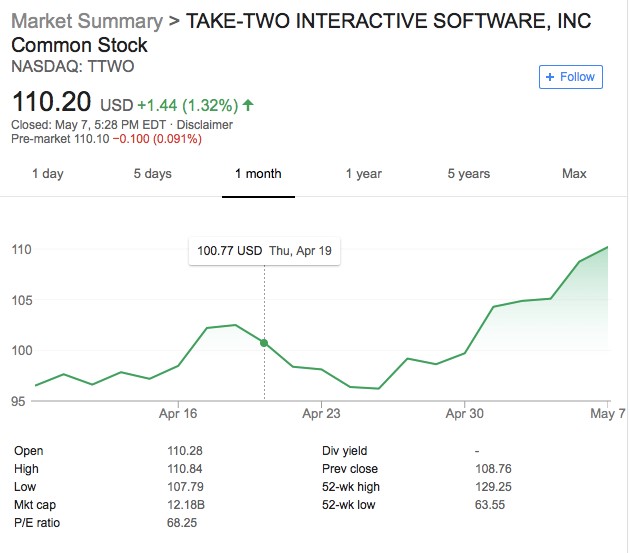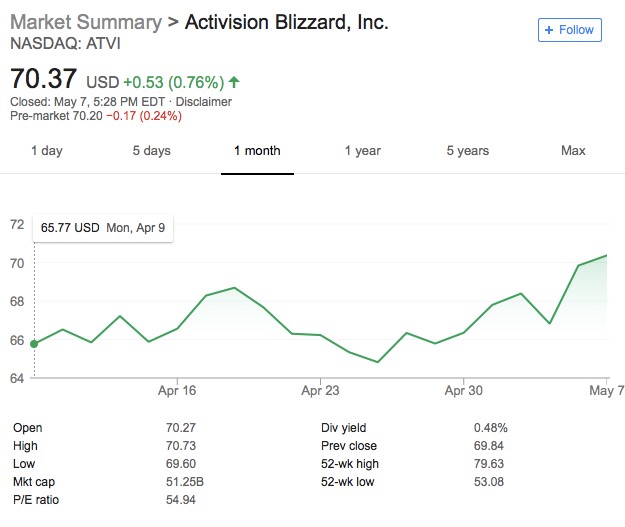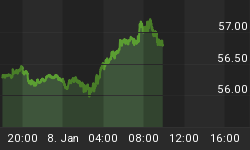Mankind’s obsession with apocalyptic survival themes and last-man standing scenarios, widespread frustration at a world gone mad, or just sheer boredom—whatever the reason, the online video game Fortnite: Battle Royale is a global addiction that is thoroughly disrupting the industry.
This is where the Hunger Games meets Minecraft. It’s free, it’s fun, and it’s now the hottest new pop culture hit in the world, with tens of millions of players globally. The industry is getting nervous.
In March, Fortnite managed to wipe over $6 billion from industry leader Activision Blizzard before it recovered. Electronic Arts (EA) and Take-Two Interactive Software (TTWO) are also reeling in uncertainty from the Fortnite explosion.
April was also a tumultuous month for these stocks, but May is looking better as everyone settles down.

(Click to enlarge)

(Click to enlarge)

(Click to enlarge)
By Epic Games, Fortnite: Battle Royale was released on in September last year, and already it’s fully disrupting the gaming industry.
And it helps when the biggest YouTubers and streamers, along with a long list of celebrities, have picked up the gauntlet, streaming their hours of play in a game that somehow makes the end of the world fun—complete with new dance moves and outlandish costumes. Related: These Infamous Investors Are Predicting A Market Crash
But the biggest disrupter to the industry is the way Fortnite handles monetization. It’s free to play, but you can buy all kinds of loot that has hit pop culture proportions, including skins, crazy costumes and the like, but it doesn’t give you an advantage over those who don’t spend on the battlefield.
They also make money on the Battle Pass. Offered on a seasonal basis, each Battle Pass costs $10 and poses challenges in 100 tiers to players that can unlock new emotes, in-game currency, skins and other loot. And the Fortnite loot is becoming addictive itself.
Now, Fortnite is on another tear with an Avengers update launching today that will allow players to ‘mashup’ with Thanos, the villain in the smash box-office hit that is the latest in the movie series. The movie hit $1 billion at the box office in only 11 days, breaking all kinds of records.
So how worried should industry leaders be?
Quite a bit, actually. In the first week of May, reports emerged that less than two months after the release of Fortnite for iOS, the game hit $50 million in revenue. And some say it’s bringing in $1.2 million a day.
So far, while some major ups and downs over the past couple of months, the top stocks in this industry are still earning big and share prices are holding strong for the most part, but they all have lessons to learn from Fortnite.
Related: Cybercrime Is Soaring In Emerging Markets
Back in March, when Fortnite caused a 10-percent drop in Activision Blizzard, CNBC quoted analyst Timothy O’Shea as writing: “The concern is Call of Duty and Overwatch gamers will churn to Fortnite. But we believe these game audiences, especially the hardcore 'spenders,' are less fluid than many investors believe. This looks like the classic short-term issue, we are predisposed to aggressively buy the dip given there is no change to our positive long-term stance on Activision Blizzard.
There’s a lot of stake here, with just two segments of the online gaming industry—free-to-play and pay-to-play generating early $20 billion in revenue in 2016 alone.
Overall, the global digital video game market grew by 6 percent year-on-year to $9.1 billion for 2017.
And the new ‘Battle Royale’ is about how much you can offer for free, while still finding ways to monetize for huge revenues.
By Michael Scott for Safehaven.com
More Top Reads From Safehaven.com:

















